
The family Asteraceae, with the original name Compositae, consists of over 32,000 known species of flowering plants in over 1,900 genera within the order Asterales. Commonly referred to as the aster, daisy, composite, or sunflower family, Compositae were first described in the year 1740. The number of species in Asteraceae is rivaled only by the Orchidaceae, and which is the larger family is unclear as the quantity of extant species in each family is unknown.

Senecio is a genus of flowering plants in the daisy family (Asteraceae) that includes ragworts and groundsels.

Senecio ampullaceus, also known as Texas ragwort, Texas squaw-weed, Texas groundsel, and Texas butterweed, is a species of Senecio in the family Asteraceae, receiving its Latin name ampullaceus from its flask shaped flower-head. It is recommended for landscape use in its native Texas.

Senecio squalidus, known as Oxford ragwort, is a flowering plant in the daisy family Asteraceae. It is a yellow-flowered herbaceous plant, native to mountainous, rocky or volcanic areas, that has managed to find other homes on man-made and natural piles of rocks, war-ruined neighborhoods and even on stone walls. These habitats resemble its well drained natural rocky homeland. The plants have spread via the wind, rail and the activities of botanists. The travels of this short-lived perennial, biennial, or winter annual make it a good subject for studies of the evolution and ecology of flowering plants.

Senecio eboracensis, the York groundsel or York radiate groundsel, is a flowering plant in the daisy family Asteraceae. It is a hybrid between a native and a non-native introduced species, which naturalised in England but the population failed to sustain itself. It was brought back by captive cultivation. It is a self-pollinating hybrid species of ragwort and one of only six new plant species to be discovered in either the United Kingdom or North America in the last 100 years.
Senecio transmarinus is a sometimes straggling member of the flowering plants Asteraceae and species of the genus Senecio a perennial herb that grows on the higher elevations of the Rwenzori Mountains in Uganda. It is also found in Rwanda and the Democratic Republic of the Congo. The inflorescences consist of several flowerheads with large yellow ray florets.
Senecio maranguensis a 2-meter (6 foot) woody shrub or 6 meter (20 feet) climbing shrub from the family Asteraceae and species of the genus Senecio which makes its home at the same altitudes as the bamboo on the slopes of the mountains in East Africa.
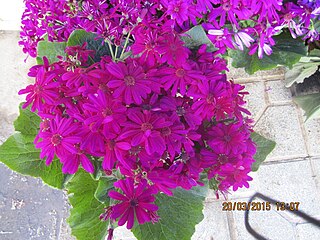
Cineraria deltoidea is a perennial flowering plant of the family Asteraceae and the genus Cineraria which is also the closest known relative of the giant Dendrosenecio of East Africa.
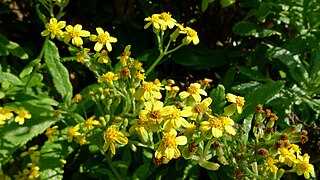
Senecio madagascariensis, also known as Madagascar ragwort, is a species of the genus Senecio and family Asteraceae that is native to Southern Africa. Other common names include Madagascar groundsel and fireweed. It has been included on the noxious weeds list for Hawaii and the reject list for Australia. S.madagascariensis is the diploid cytotype of S.inaequidens.

Carphochaete is a genus of North American flowering plants in the family Asteraceae. They are native to Mexico and the southwestern United States. They are known commonly as bristleheads.

Senecio aphanactis, known by the common names chaparral ragwort, rayless ragwort, and California groundsel, is a species of flowering plant in the aster family.
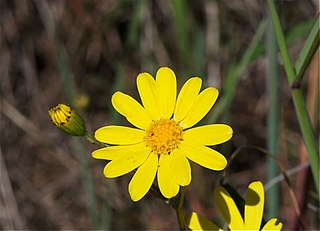
Senecio californicus is a species of flowering plant in the aster family known by the common name California ragwort.
Senecio clarkianus is a species of flowering plant in the aster family known by the common name Clark's ragwort. It is endemic to the Sierra Nevada of California, where it grows in the moist meadows on the western slopes of the range. It is a perennial herb growing up to 1.2 meters tall from a caudex and fibrous root system. The solitary erect stem is lined evenly with leaves up to about 18 centimeters long, their blades deeply lobed or dissected into narrow, pointed segments. The herbage is hairy to woolly in texture. The inflorescence bears several flower heads which are lined with green-tipped phyllaries. They contain many yellow disc florets and each has usually 8 or 13 narrow yellow ray florets about a centimeter long, sometimes longer.

Senecio hydrophiloides is a species of flowering plant in the aster family known by the common names tall groundsel and sweet marsh ragwort. It is native to western North America from British Columbia and Alberta to northern California to Utah, where it grows in wet meadows and similar habitat. It is a biennial or perennial herb producing a single erect stem or a cluster of a few stems which may exceed one meter in maximum height. The plants are green to red in color and usually without hairs, but new growth can be woolly. The leaves are lance-shaped to oval with toothed edges, the blades up to 25 centimeters long and borne on long winged petioles. The leaves are firm and sometimes a bit fleshy. The inflorescence is a loose or dense cluster of up to 30 or more flower heads lined with black-tipped phyllaries. They contain many yellowish disc florets at the center and often have some yellow ray florets, though these are sometimes absent. Senecio Hydrophiloides can cause Dermatitis.
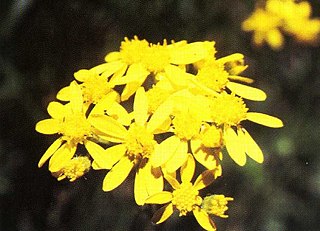
Senecio hydrophilus is a species of flowering plant in the aster family known by the common names water ragwort and alkali-marsh ragwort. It is native to western North America from British Columbia to California to Colorado, where it grows in swampy places such as marshes. It can grow in standing water, including alkaline and salty water. It is a biennial or perennial herb producing a single erect stem or a cluster of a few stems which may exceed one meter in maximum height, at times approaching two meters. The stem is hollow, waxy in texture, and often pale green in color, and it emerges from a small caudex. The thick leaves are lance-shaped to oval with smooth or toothed edges, the blades up to 20 centimeters long and borne on petioles. Smaller leaves occur farther up the stem. The inflorescence is one or more large, spreading clusters of many flower heads. They contain many yellowish disc florets at the center and sometimes have small yellow ray florets as well.

Senecio mohavensis, known by the common name Mojave ragwort, is a species of flowering plant in the aster family.
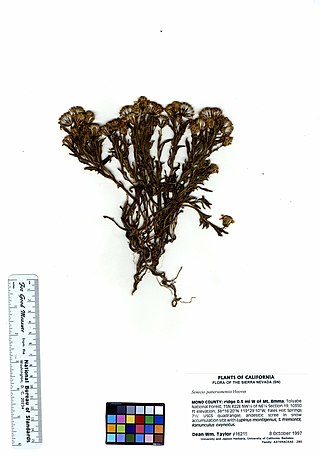
Senecio pattersonensis is an uncommon species of flowering plant in the aster family known by the common names Mono ragwort. and Mount Patterson senecio.
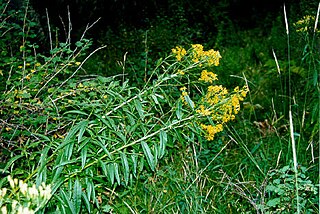
Senecio serra is a species of flowering plant in the aster family known by the common names tall ragwort and sawtooth groundsel. It is native to the western United States, where it can be found in several types of habitat, including sagebrush and woodlands. It is a perennial herb producing a single erect stem or a cluster of stems from a branched, woody caudex. The plant can exceed two meters in height. It is hairless in texture, with young plants sometimes appearing fuzzy, and green to red-tinged in color. The leaves have lance-shaped blades up to 20 centimeters long borne on short petioles, the leaves occurring evenly all along the stems. The inflorescence is a spreading array of many flower heads, each lined with green- or black-tipped phyllaries. The heads contain yellow disc florets and 5 to 8 yellow ray florets each under a centimeter long.
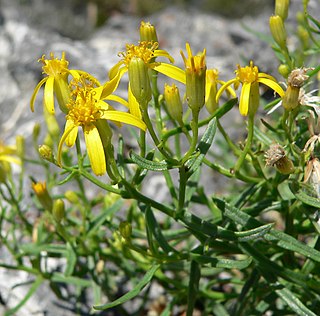
Senecio spartioides is a species of flowering plant in the aster family known by the common name broom-like ragwort. It is native to the western United States as far east as the Dakotas and Texas, and northern Mexico. It can be found in dry, rocky, often disturbed areas in a number of habitat types. It is a subshrub which can exceed a meter in height, its arching stems growing from a woody-topped taproot. The leaves are linear in shape and up to 10 centimeters long. The leaves usually have smooth, unlobed edges, but slightly lobed leaves are seen at times. The leaves are evenly distributed along the stems, the ones low on the stems withering away early, giving the plant a naked appearance on the lower half while the top is still lush green and blooming. The inflorescences are spreading, flat-topped arrays of many cylindrical flower heads. The heads contain yellow disc florets and generally either 5 or 8 ray florets each about a centimeter long.

Packera franciscana is a rare species of flowering plant in the aster family known by the common name San Francisco Peaks groundsel, or San Francisco Peaks ragwort. It is endemic to Arizona in the United States, where it is known only from the San Francisco Peaks in Coconino County. It is threatened by recreational activities in its habitat. It is a federally listed threatened species of the United States.


















